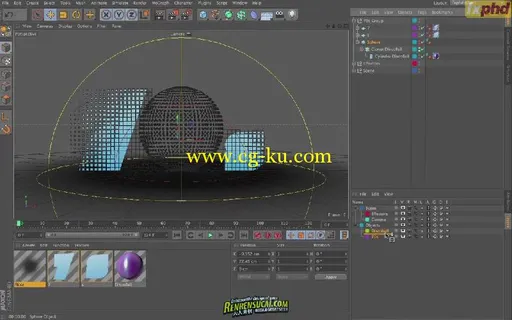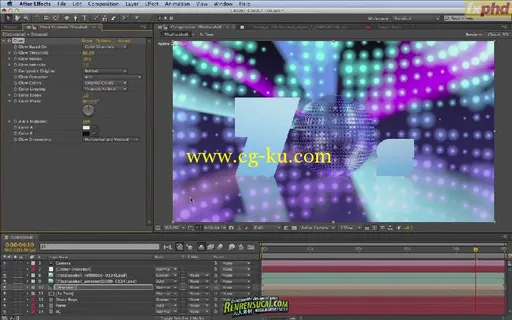本教程是由FXPHD机构出品的C4D动画设计应用教程,时长:6小时10分,教程使用软件:Cinema4D,大小:1.60 GB,MP4视频格式,附工程源文件,作者:Tim Clapham,语言:英语。
Cinema 4D是一套由德国公司Maxon Computer开发的3D绘图软件,以及高的运算速度和强大的渲染插件著称。Cinema 4D 应用广泛,在广告、电影、工业设计、等方面都有出色的表现,例如影片《阿凡达》有花鸦三维影动研究室中国工作人员使用Cinema 4D制作了部分场景,在这样的大片中看到C4D的表现是很优秀的。在其他动画电影中也使用到C4D的有****很多如《毁灭战士》(Doom)、《范海辛》〈Van Helsing〉、《蜘蛛侠》、以及动画片《极地特快》、《丛林总动员》(Open Season)等等。它正成为许多一流艺术家和电影公司的首选,Cinema 4D已经走向成熟,很多模块的功能在同类软件中是代表科技进步的成果。
FXPHD C4D207 Cinema4D and Design III
Tim Clapham from Luxx returns with another course for Cinema4D and After Effects users. Primarily aimed at intermediate users, some knowledge of Cinema4D is definitely useful. However, Clapham is very thorough with his explanations and most competent users should be able to follow along without any problem.
The term is compiled from a selection of classes that were previously included in our C4D203 and C4D205 courses. Due to advances in the application and our industry in general, many of the techniques that Clapham covered have been superseded by superior features and methods. Therefore, we felt it was a good idea to remove the redundant and update the relevant. Clapham will be using Cinema4D release 13, although users of release 12 should also be able to follow the course. Although the emphasis is on working with Cinema4D, The course will certainly be dipping into After Effects from time to time, specifically to cover the workflow when transferring 3D information between Cinema4D and After Effects.
The updated and re-written classes discuss and explore lighting in Cinema4D, as well as multipass rendering and compositing in After Effects. The classes have also been updated to include the latest features of Cinema4D such as Linear Workflow and the Physical Renderer, as well as configuring your project settings in After Effects to ensure the correct composite. This course covers many useful features in Cinema4D such as MoGraph, Xpresso, Multipass Rendering, Lighting and Animation Techniques. Tim also covers smaller but incredibly important issues such as scene management, render optimisation and workflow.
Class 1: Week one of a two week class. Using a python script to import Adobe Swatches. Building a stylized mirrorball using a Cloner object and a combination of effectors. Adding some type which will be wiped on using effectors. Creating some materials including use of the falloff and lumas shaders.
Class 2: Week two of a two week class. Animating the Camera, lights and Effectors. Setting up the render passes and configuring colour management. Exporting an AEC file to transfer 3D data to After Effects. Compositing the 3D render in After Effects, using Trapcode Form to demonstrate the link with the C4D Camera export.
Class 3: An exploration of lighting principles Week one of a two week class discussing lighting techniques and principles, specifically lighting in Cinema4D. This week we look at some lighting examples, build a basic 3 point light rig. We then explore several methods to simulate bounce light and ambient lighting.
Class 4: Week two of a two week class discussing lighting techniques and principles, specifically lighting in Cinema4D. This week we create a light setup for a studio and then a daylight rig. Rendering using multipass and separate light passes we produce a third look in After Effects.
Class 5: Methods of animating cameras. In this class we look at several methods of animating cameras. We will also look at a technique to create automatic banking on your camera animations. Finally we build a versatile rig that can be used for easily creating complex camera moves.
Class 6: Baking Textures, Shaders and Illumination. This class will cover the concept of baking textures within Cinema4D. Using the Bake Texture and Bake Object features. Creating significant speed increases to your renders by baking processor intensive shaders and lighting setups. Baking of spherical maps for creation of custom textures, environment maps and generating HDR images.
Class 7: Introducing Sketch and Toon This class looks into the Sketch and Toon Module. First analyzing the Render Settings and then creating a custom Sketch material.
Class 8: Creating an animated ident with audio The final three weeks of the course will be dedicated to the creation of an animated indent from concept through 3D construction, rendering including final grading and compositing. With the class will be provided an audio track which will be the foundation of the animation and dictate the underlying structure. After exploring some automatic techniques of animating to sound, the class will develop into some more abstract and cg-ku.com less conventional uses of the audio. This will involve using Xpresso to link parameters to the sampled and refined audio. Using the MoGraph Sound Effector. Animating the camera and linking the motion to the audio samples. Lighting and rendering using Multipass, with final composite and grade in After Effects.
Class 9: Continue creating an animated indent with audio.
Class 10: Continue creating an animated indent with audio.
迅雷快传+迅雷离线地址:
http://kuai.xunlei.com/d/UGEPQPGPSUDX
或者
[thunder]Thunder://QUFmdHA6Ly9ycnNjOnJyc2NAMTEzLjAuNC4zMC+htkM0RLavu63J6LzG06bTw73Ms8yht3JyLXNjLmNvbcjLyMvL2LLELnBhcnQyLnJhcgpaWg==[/thunder]
[thunder]Thunder://QUFmdHA6Ly9ycnNjOnJyc2NAMTEzLjAuNC4zMC+htkM0RLavu63J6LzG06bTw73Ms8yht3JyLXNjLmNvbcjLyMvL2LLELnBhcnQxLnJhcgpaWg==[/thunder]



发布日期: 2012-5-25